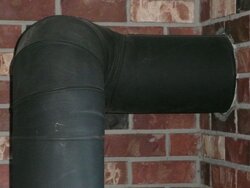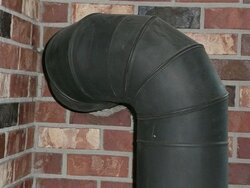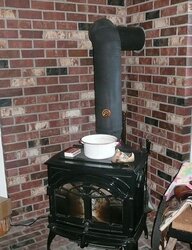Sorry for the long post, but here it goes:
We own a trilevel home: Lowest level is 12x17 (204 sq ft), two stairs up is the kitchen (no wall between) 13x17,(221 sq ft) and the dining room on the same level as the kitchen at 12x12 (144 sqft) and attached front room at 17x17(289 sq ft with cathedral ceiling (our primary sitting room)). There is an upstairs but did not measure. total for entire house is 1900 sq ft. Thermostat is in the front room, stove is in the lowest level in the furthest corner from the front room. You get the idea, typical trilevel layout.
It came with the "Cape Cod" manufactured in 1999. Problem we are having is that it seems the "cape cod" is oversized. The lowest room gets very hot so we tend to run it at a lower temperature, which causes more creosote, etc. It also blows smoke out like crazy when the door is opened (probably a pipe issue which we will be fixing, it has about 6' of 8" going into 6") It is rated: Heat Output Range 11,000 to 43,000 btu/hr EPA, Firebox capacity 2.4 cubic Ft.
It will be used daily 6-8 months of the year and there is a ceiling fan above the stove area.
We have been eyeing the Lopi republic 1750 and 1250 as they have a more "modern look". My wife is concerned that if we get the 1750 we will have to run it too cool which will cause more creosote. She really likes the Scan units, but they are kinda spendy....
So, after all of that info, which I am certain most of you can grasp, any thought on a replacement would be great!
Thanks,
Bob
We own a trilevel home: Lowest level is 12x17 (204 sq ft), two stairs up is the kitchen (no wall between) 13x17,(221 sq ft) and the dining room on the same level as the kitchen at 12x12 (144 sqft) and attached front room at 17x17(289 sq ft with cathedral ceiling (our primary sitting room)). There is an upstairs but did not measure. total for entire house is 1900 sq ft. Thermostat is in the front room, stove is in the lowest level in the furthest corner from the front room. You get the idea, typical trilevel layout.
It came with the "Cape Cod" manufactured in 1999. Problem we are having is that it seems the "cape cod" is oversized. The lowest room gets very hot so we tend to run it at a lower temperature, which causes more creosote, etc. It also blows smoke out like crazy when the door is opened (probably a pipe issue which we will be fixing, it has about 6' of 8" going into 6") It is rated: Heat Output Range 11,000 to 43,000 btu/hr EPA, Firebox capacity 2.4 cubic Ft.
It will be used daily 6-8 months of the year and there is a ceiling fan above the stove area.
We have been eyeing the Lopi republic 1750 and 1250 as they have a more "modern look". My wife is concerned that if we get the 1750 we will have to run it too cool which will cause more creosote. She really likes the Scan units, but they are kinda spendy....
So, after all of that info, which I am certain most of you can grasp, any thought on a replacement would be great!
Thanks,
Bob




